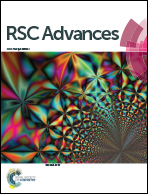An advanced asymmetric supercapacitor based on a novel ternary graphene/nickel/nickel oxide and porous carbon electrode with superior electrochemical performance†
Abstract
A novel ternary system composed of graphene, nickel and nickel oxide (RGO/Ni/NiO) has been constructed as a positive electrode for the first time via a facile route. The RGO/Ni/NiO composite exhibits excellent electrochemical performance, and could achieve a high specific capacitance of 1410 F g−1 at 1 A g−1 and 1020 F g−1 at a high current density of 15 A g−1. Meanwhile, porous carbon (PC) as a negative electrode has been synthesized by using activated carbon (AC) with further KOH activation. With the above two kinds of electrode materials, an advanced asymmetric supercapacitor of RGO/Ni/NiO//PC is assembled and studied. The optimized asymmetric supercapacitor displays a superb performance with a maximum specific capacitance of 183.8 F g−1 and high energy density of 65.3 W h kg−1. Even at a high power density of 8000 W kg−1, it can maintain 42.2 W h kg−1, indicating remarkable rate performance. Additionally, the RGO/Ni/NiO//PC asymmetric supercapacitor retains a high specific capacitance of 120 F g−1 without capacitance loss after 3000 cycles at 8 A g−1, demonstrating its long cycle life. This work provides new insight into the design of RGO/Ni/NiO as a positive electrode to fabricate high-performance asymmetric supercapacitors. The obtained RGO/Ni/NiO//PC shows superior electrochemical performance, suggesting a promising application in energy-storage devices.


 Please wait while we load your content...
Please wait while we load your content...